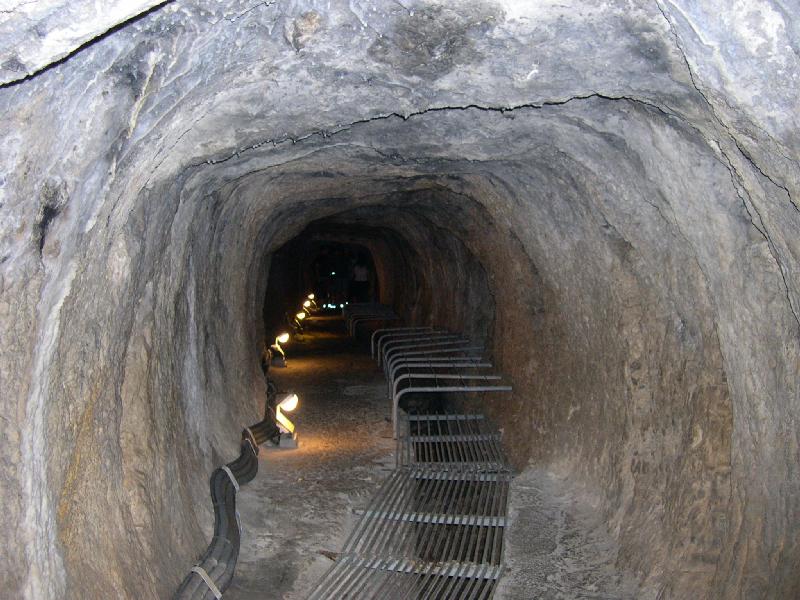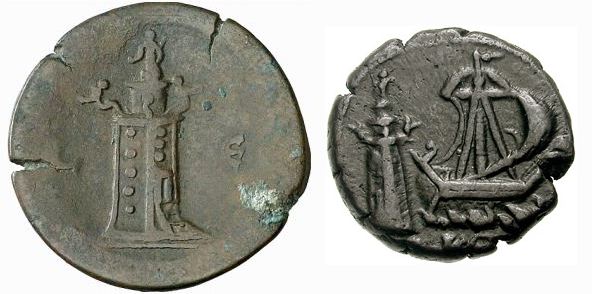|
Taposiris Magna
Taposiris Magna is a city established by Pharaoh Ptolemy II Philadelphus between 280 and 270 BC. The name means "great tomb of Osiris", which Plutarch identifies with an Egyptian temple in the city. After Alexander the Great conquered Egypt in 332 BC and established Alexandria, the city of Taposiris Magna became a center for religious festival of Khoiak. The Ptolemaic Kingdom, the last Egyptian dynasty, was established following this, as a Greek state during this Hellenistic Period that lasted until the death of Cleopatra VII in 30 BC. Napoleon arrived in Egypt during 1798 and French scientists subsequently conducted a survey of the architecture of the city published in the ''Description de l'Égypte'' In the twentieth century, excavations of the site were started under the Italian, Evaristo Breccia. Callisthenes states that Alexander the Great visited the city on his way to Siwa Oasis, which gives credence to the theory that there must have been a town there in the Hellenist ... [...More Info...] [...Related Items...] OR: [Wikipedia] [Google] [Baidu] |
Lake Mariout
Lake Mariout ( ar, بحيرة مريوط ', , also spelled Maryut or Mariut), is a brackish lake in northern Egypt near the city of Alexandria. The lake area covered and had a navigable canal at the beginning of the 20th century, but at the beginning of the 21st century, it covers only about . Etymology The name of Lake Mariout derives from the Hellenized name of Mareotis ( grc, Μαρεῶτις) or Marea, which was named in the Ptolemic Period. Overview In antiquity, the lake was much larger than it is now, extending further to the south and west and occupying around . It had no mouth connecting it to the Mediterranean, being fed with Nile water via a number of canals. By the twelfth century the lake had dwindled to a collection of salt lakes and salt flats and it had dried up by the Late Middle Ages. At least 250 years ago, the lake was fresh water, and much of it would dry up during the period just before the Nile flooded again. A storm in 1770 breached the sea wall ... [...More Info...] [...Related Items...] OR: [Wikipedia] [Google] [Baidu] |
Zahi Hawass
Zahi Abass Hawass ( ar, زاهي حواس; born May 28, 1947) is an Egyptian archaeologist, Egyptologist, and former Minister of State for Antiquities Affairs, serving twice. He has also worked at archaeological sites in the Nile Delta, the Western Desert, and the Upper Nile Valley. Early life Hawass was born in a small village near Damietta, Egypt. Although he originally dreamed of becoming an attorney, he obtained a Bachelor of Arts degree in Greek and Roman Archaeology from Alexandria University in 1967. In 1979, Hawass earned a diploma in Egyptology from Cairo University. He then worked at the Great Pyramids as an inspector—a combination of administrator and archaeologist. When he was 33 years old, Hawass was awarded a Fulbright Fellowship to attend the University of Pennsylvania in Philadelphia to study Egyptology, earning a Master of Arts degree in the subject and also one in Syro-Palestinian Archaeology in 1983, and his PhD in Egyptology in 1987 from the Graduate Grou ... [...More Info...] [...Related Items...] OR: [Wikipedia] [Google] [Baidu] |
Archaeologist
Archaeology or archeology is the scientific study of human activity through the recovery and analysis of material culture. The archaeological record consists of artifacts, architecture, biofacts or ecofacts, sites, and cultural landscapes. Archaeology can be considered both a social science and a branch of the humanities. It is usually considered an independent academic discipline, but may also be classified as part of anthropology (in North America – the four-field approach), history or geography. Archaeologists study human prehistory and history, from the development of the first stone tools at Lomekwi in East Africa 3.3 million years ago up until recent decades. Archaeology is distinct from palaeontology, which is the study of fossil remains. Archaeology is particularly important for learning about prehistoric societies, for which, by definition, there are no written records. Prehistory includes over 99% of the human past, from the Paleolithic until the adve ... [...More Info...] [...Related Items...] OR: [Wikipedia] [Google] [Baidu] |
Live Science
Live Science is a science news website run by Future via Purch, which it purchased from Imaginova in 2009. Stories and editorial commentary are typically syndicated to major news outlets, such as Yahoo!, MSNBC, AOL, and Fox News.{{fact, date=March 2020 Live Science was originally launched in 2004, but was subsequently shut down and re-launched in 2007. Live Science covers scientific breakthroughs, research ventures and odd facts from around the world in an online newsmagazine format. Purch consumer brands (including Live Science) were acquired by Future in 2018.{{Cite web , url=https://www.futureplc.com/brand/live-science/ , title=Live Science , work=Future plc Future plc is an international multimedia company established in the United Kingdom in 1985. The company has over 220 brands that span magazines, newsletters, websites, and events in fields such as video games, technology, films, music, photogr ... , access-date=18 December 2018 References {{reflist External links ... [...More Info...] [...Related Items...] OR: [Wikipedia] [Google] [Baidu] |
Greece
Greece,, or , romanized: ', officially the Hellenic Republic, is a country in Southeast Europe. It is situated on the southern tip of the Balkans, and is located at the crossroads of Europe, Asia, and Africa. Greece shares land borders with Albania to the northwest, North Macedonia and Bulgaria to the north, and Turkey to the northeast. The Aegean Sea lies to the east of the Geography of Greece, mainland, the Ionian Sea to the west, and the Sea of Crete and the Mediterranean Sea to the south. Greece has the longest coastline on the Mediterranean Basin, featuring List of islands of Greece, thousands of islands. The country consists of nine Geographic regions of Greece, traditional geographic regions, and has a population of approximately 10.4 million. Athens is the nation's capital and List of cities and towns in Greece, largest city, followed by Thessaloniki and Patras. Greece is considered the cradle of Western culture, Western civilization, being the birthplace of Athenian ... [...More Info...] [...Related Items...] OR: [Wikipedia] [Google] [Baidu] |
Tunnel Of Eupalinos
The Tunnel of Eupalinos or Eupalinian aqueduct ( el, Ευπαλίνιον όρυγμα, translit=Efpalinion orygma) is a tunnel of length running through Mount Kastro in Samos, Greece, built in the 6th century BC to serve as an aqueduct. The tunnel is the second known tunnel in history which was excavated from both ends (, "having two openings"), and the first with a geometry-based approach in doing so. Today it is a popular tourist attraction. The tunnel is inscribed on the UNESCO World Heritage List along with the nearby Pythagoreion and Heraion of Samos, and it was designated as an International Historic Civil Engineering Landmark in 2017. Early history The Eupalinian aqueduct is described by Herodotus (''Histories'' 3.60), without whom it might not have been discovered: :I have dwelt longer upon the history of the Samians than I should otherwise have done, because they are responsible for three of the greatest building and engineering feats in the Greek world: the first i ... [...More Info...] [...Related Items...] OR: [Wikipedia] [Google] [Baidu] |
Necropolis
A necropolis (plural necropolises, necropoles, necropoleis, necropoli) is a large, designed cemetery with elaborate tomb monuments. The name stems from the Ancient Greek ''nekropolis'', literally meaning "city of the dead". The term usually implies a separate burial site at a distance from a city, as opposed to tombs within cities, which were common in various places and periods of history. They are different from grave fields, which did not have structures or markers above the ground. While the word is most commonly used for ancient sites, the name was revived in the early 19th century and applied to planned city cemeteries, such as the Glasgow Necropolis. Necropoli in the ancient world Egypt Ancient Egypt is noted for multiple necropoleis. Ancient Egyptian funerary practices and beliefs about the afterlife led to the construction of several extensive necropoleis to secure and provision the dead in the hereafter. These necropoleis are therefore major archaeological si ... [...More Info...] [...Related Items...] OR: [Wikipedia] [Google] [Baidu] |
Environs D'Alexandrie (Alexandria) (Taposiris)
Environ or environs may refer to: * Environ (Loft), a New York performance space * Ramboll Environ, or ''ENVIRON'', a consulting firm in Arlington, Virginia * ''Environs'' (journal), a student-run law review covering environmental subjects * Environs, or surroundings Surroundings are the area around a given physical or geographical point or place. The exact definition depends on the field. Surroundings can also be used in geography (when it is more precisely known as vicinity, or vicinage) and mathematics, a ..., the area around a given physical or geographical point or place See also * * * Environment (other) {{disambig ... [...More Info...] [...Related Items...] OR: [Wikipedia] [Google] [Baidu] |
Cleopatra
Cleopatra VII Philopator ( grc-gre, Κλεοπάτρα Φιλοπάτωρ}, "Cleopatra the father-beloved"; 69 BC10 August 30 BC) was Queen of the Ptolemaic Kingdom of Egypt from 51 to 30 BC, and its last active ruler.She was also a diplomat, naval commander, linguist, and medical author; see and . A member of the Ptolemaic dynasty, she was a descendant of its founder Ptolemy I Soter, a Macedonian Greek general and companion of Alexander the Great. writes about Ptolemy I Soter: "The Ptolemaic dynasty, of which Cleopatra was the last representative, was founded at the end of the fourth century BC. The Ptolemies were not of Egyptian extraction, but stemmed from Ptolemy Soter, a Macedonian Greek in the entourage of Alexander the Great."For additional sources that describe the Ptolemaic dynasty as " Macedonian Greek", please see , , , and . Alternatively, describes them as a "Macedonian, Greek-speaking" dynasty. Other sources such as and describe the Ptolemies a ... [...More Info...] [...Related Items...] OR: [Wikipedia] [Google] [Baidu] |
Lighthouse Of Alexandria
The Lighthouse of Alexandria, sometimes called the Pharos of Alexandria (; Ancient Greek: ὁ Φάρος τῆς Ἀλεξανδρείας, contemporary Koine ), was a lighthouse built by the Ptolemaic Kingdom of Ancient Egypt, during the reign of Ptolemy II Philadelphus (280–247 BC). It has been estimated to have been at least in overall height. One of the Seven Wonders of the Ancient World, for many centuries it was one of the tallest man-made structures in the world. The lighthouse was severely damaged by three earthquakes between 956 and 1323 AD and became an abandoned ruin. It was the third-longest surviving ancient wonder (after the Mausoleum at Halicarnassus and the extant Great Pyramid of Giza), surviving in part until 1480, when the last of its remnant stones were used to build the Citadel of Qaitbay on the site. In 1994, a team of French archaeologists dove into the water of Alexandria's Eastern Harbour and discovered some remains of the lighthouse on the sea f ... [...More Info...] [...Related Items...] OR: [Wikipedia] [Google] [Baidu] |
Limestone
Limestone ( calcium carbonate ) is a type of carbonate sedimentary rock which is the main source of the material lime. It is composed mostly of the minerals calcite and aragonite, which are different crystal forms of . Limestone forms when these minerals precipitate out of water containing dissolved calcium. This can take place through both biological and nonbiological processes, though biological processes, such as the accumulation of corals and shells in the sea, have likely been more important for the last 540 million years. Limestone often contains fossils which provide scientists with information on ancient environments and on the evolution of life. About 20% to 25% of sedimentary rock is carbonate rock, and most of this is limestone. The remaining carbonate rock is mostly dolomite, a closely related rock, which contains a high percentage of the mineral dolomite, . ''Magnesian limestone'' is an obsolete and poorly-defined term used variously for dolomite, for limes ... [...More Info...] [...Related Items...] OR: [Wikipedia] [Google] [Baidu] |


.jpg)




